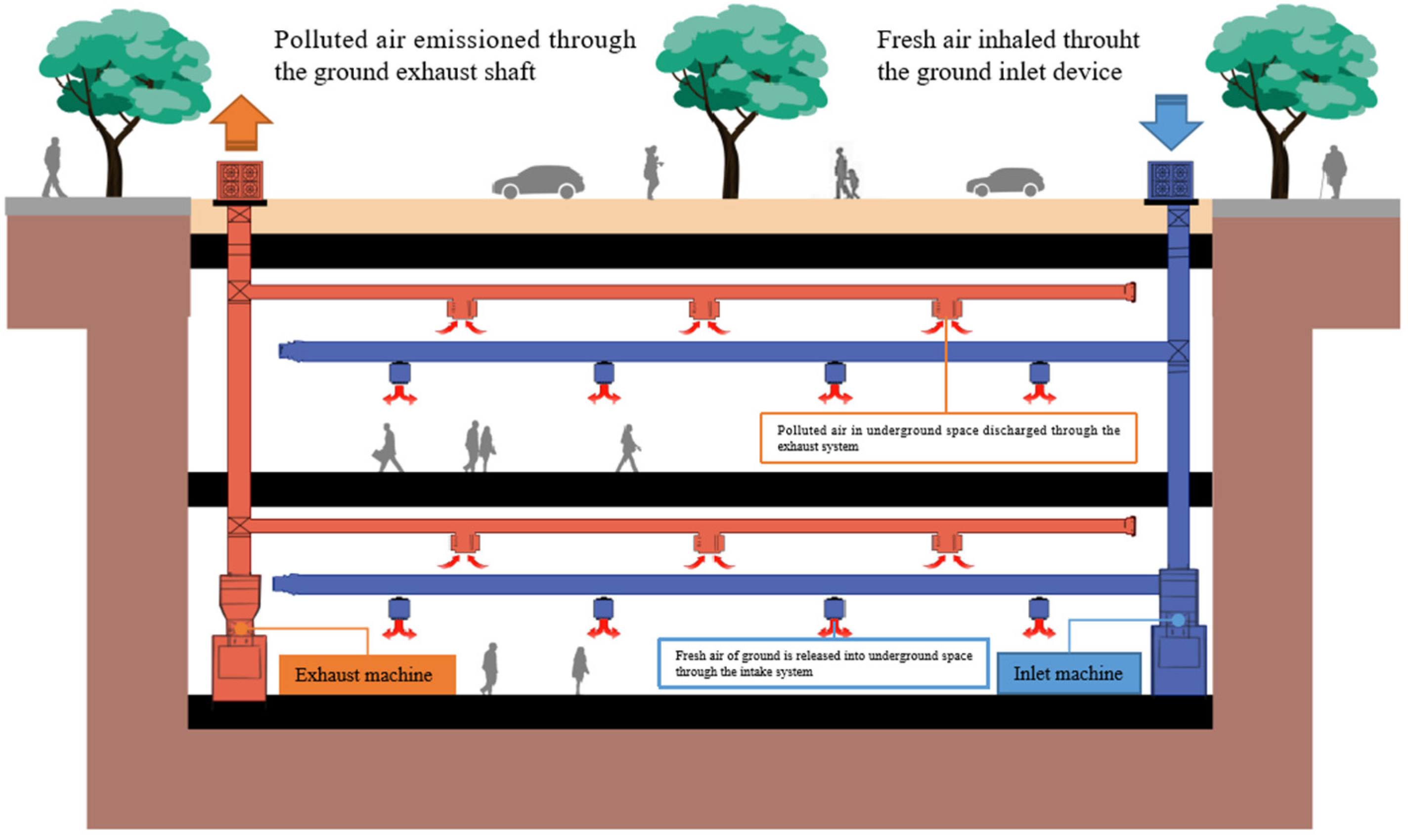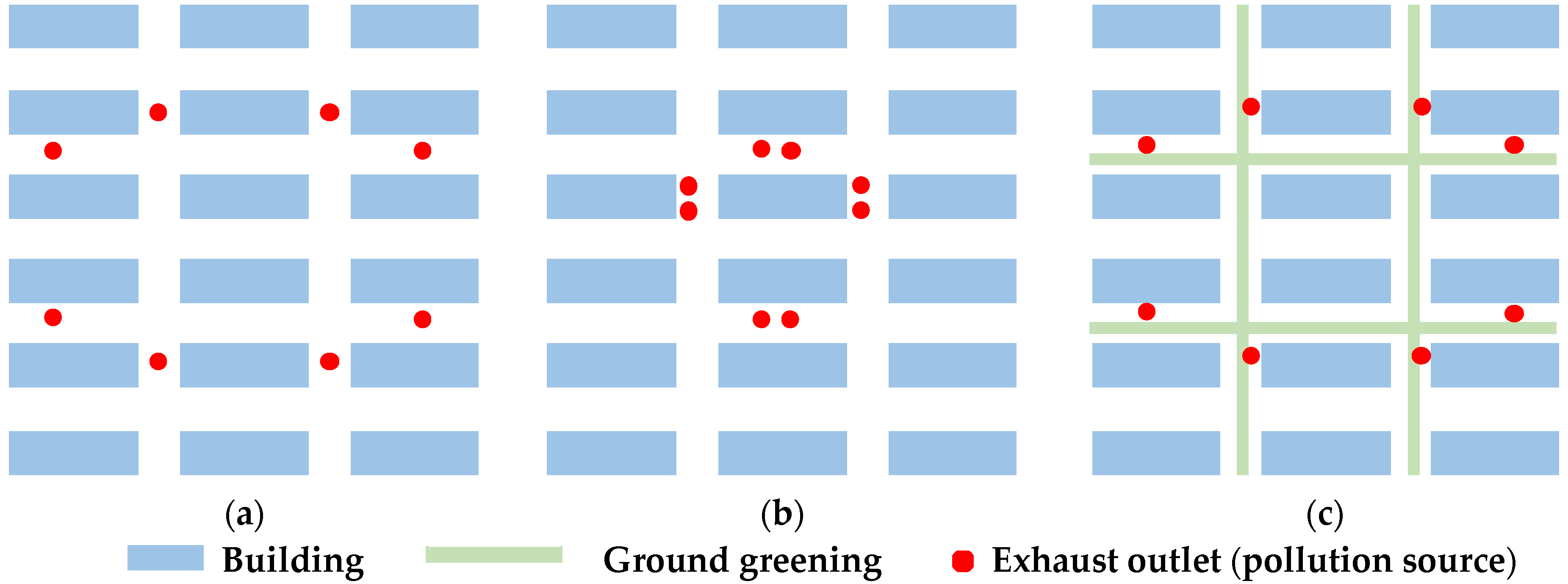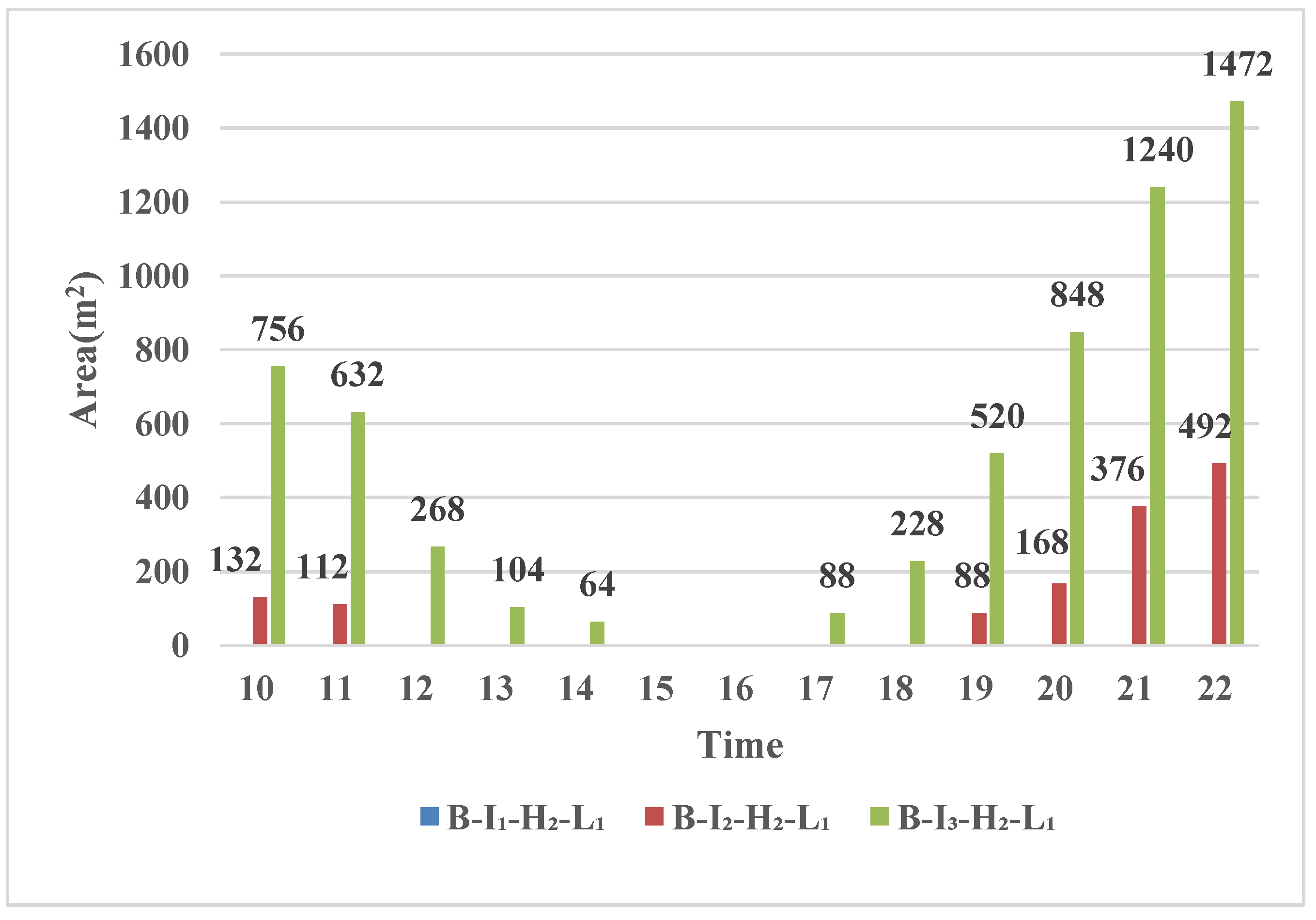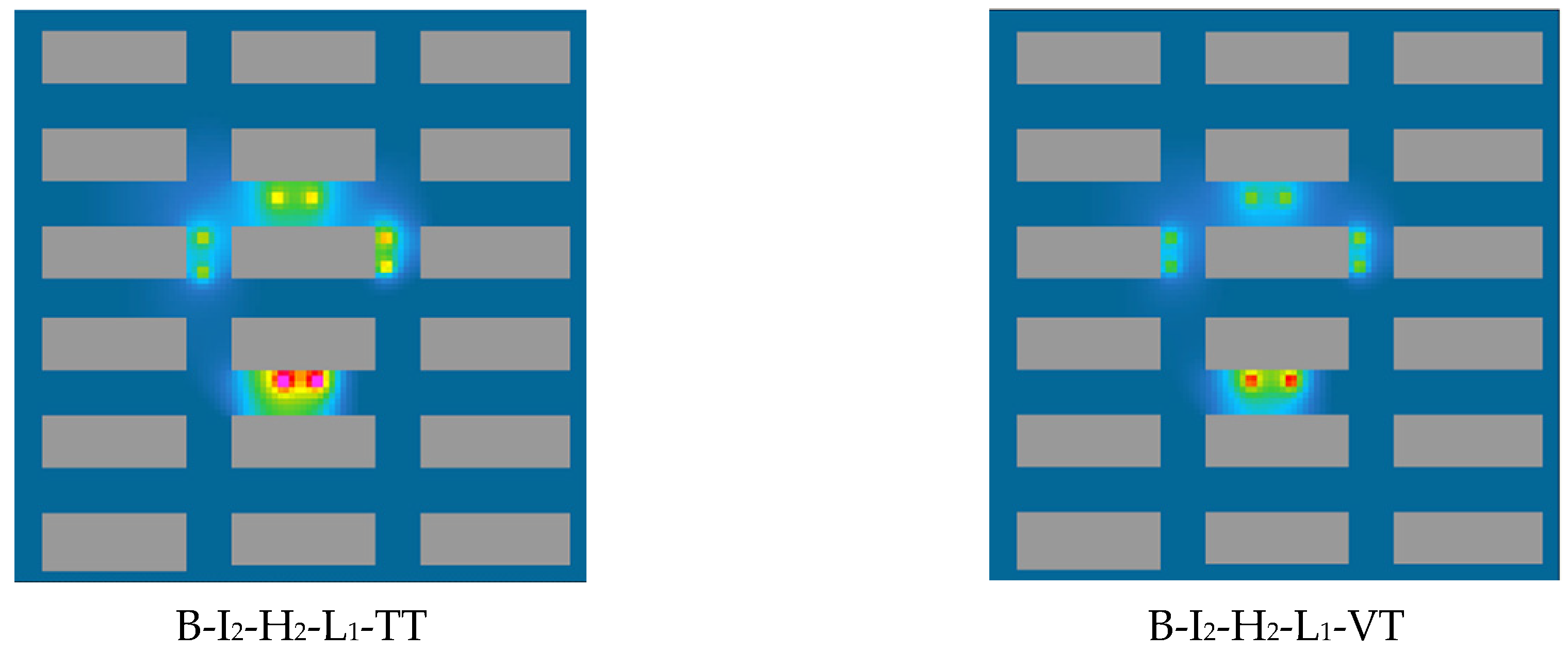The Negative Influence of Urban Underground Space Development on Urban Microclimate
Abstract
:1. Introduction
2. The Influence Mechanism of Underground Space Development on Urban Microclimate
2.1. Effects of Underground Space Development on Urban Spatial Form
2.2. Effects of Underground Space Development on Urban Underlying Surfaces
2.3. Effects on Internal Environmental Control of Urban Underground Space on Urban Microclimate
3. Research Scheme
3.1. Basic Urban Form Unit
3.2. Case Setting
3.2.1. Evaluation Index and Evaluation Criterion
3.2.2. Naming and Summary of Cases
3.2.3. Simulation Settings
- (1)
- Simulation software
- (2)
- Source intensity setting
- (3)
- Simulation parameters
4. Analysis and Discussion
4.1. Influence of Development Intensity on Air Quality
4.2. Influence of Shaft Location on Air Quality
4.3. Influence of Shaft Height on Air Quality
4.4. Influence of Ground Greening on Air Quality
5. Conclusions
- (1)
- The development intensity of underground commercial streets and outdoor CO concentration are positively correlated, whereas the height of exhaust shaft and the outdoor CO concentration are negatively correlated. Accordingly, the higher the development intensity, the higher the outdoor CO concentration and the larger the influence range. Furthermore, the higher the exhaust shaft height, the lower the outdoor CO concentration and the smaller the influence range.
- (2)
- A dispersed arrangement of exhaust shafts is more conducive to reducing the outdoor CO concentration when compared to a centralized arrangement. Therefore, to reduce the outdoor CO concentration, it is appropriate to select a dispersed arrangement for exhaust shafts.
- (3)
- Planted trees in the outdoor area of an underground commercial street development are not conducive to reducing the outdoor CO concentration. However, when big shrubs are planted, the area with an outdoor CO concentration exceeding 10 mg/m3 is the smallest. Accordingly, it is appropriate to plant big shrubs in the outdoor area of underground commercial street developments with the aim of reducing the outdoor CO concentration.
6. Limitations and Future Directions
Author Contributions
Funding
Institutional Review Board Statement
Informed Consent Statement
Data Availability Statement
Acknowledgments
Conflicts of Interest
References
- Qin, H.; Hong, B.; Huang, B.; Cui, X.; Zhang, T. How dynamic growth of avenue trees affects particulate matter dispersion: CFD simulations in street canyons. Sustain. Cities Soc. 2020, 61, 102331. [Google Scholar] [CrossRef]
- Tian, Y.; Hong, B.; Zhang, Z.; Wu, S.; Yuan, T. Factors influencing resident and tourist outdoor thermal comfort: A comparative study in China’s cold region. Sci. Total Environ. 2022, 808, 152079. [Google Scholar] [CrossRef] [PubMed]
- Hong, B.; Lin, B.R. Numerical studies of the outdoor wind environment and thermal comfort at pedestrian level in housing blocks with different building layout patterns and trees arrangement. Renew. Energy 2015, 73, 18–27. [Google Scholar] [CrossRef]
- Yang, F.; Lau, S.S.Y.; Qian, F. Thermal comfort effects of urban design strategies in high-rise urban environments in a sub-tropical climate. Archit. Sci. Rev. 2011, 54, 285–304. [Google Scholar] [CrossRef]
- Sugawara, H.; Shimizu, S.; Takahashi, H.; Hagiwara, S.; Narita, K.; Mikami, T.; Hirano, T. Thermal influence of a large green space on a hot urban environment. J. Environ. Qual. 2016, 45, 125–133. [Google Scholar] [CrossRef] [PubMed]
- Ng, E.; Chen, L.; Wang, Y.N.; Yuan, C. A study on the cooling effects of greening in a high-density city: An experience from Hong Kong. Build. Environ. 2012, 47, 256–271. [Google Scholar] [CrossRef]
- Zhang, T.; Hong, B.; Su, X.; Li, Y.; Song, L. Effects of tree seasonal characteristics on thermal-visual perception and thermal comfort. Build. Environ. 2022, 212, 108793. [Google Scholar] [CrossRef]
- Nguyen, T.; Yu, X.; Zhang, Z.; Liu, M.; Liu, X. Relationship between types of urban forest and PM2.5 capture at three growth stages of leaves. J. Environ. Sci. 2015, 27, 33–41. [Google Scholar] [CrossRef] [PubMed]
- Su, X.; Cai, H.; Chen, Z.; Feng, Q.; Su, X.; Cai, H.; Chen, Z.; Feng, Q. Influence of the Ground Greening Configuration on the Outdoor Thermal Environment in Residential Areas under Different Underground Space Overburden Thicknesses. Sustainability 2017, 9, 1656. [Google Scholar] [CrossRef]
- Su, X.; Chen, Z.; Zhao, X.; Yang, X.; Feng, Q.; Tang, H. Optimization Design of Underground Space Overburden Thickness in a Residential Area Concerning Outdoor Thermal Environment Evaluation. Sustainability 2018, 10, 3205. [Google Scholar] [CrossRef]
- Yang, X.; Zhao, Z.; Hua, R.; Su, X.; Ma, L.; Chen, Z. Simulation study on the influence of urban underground parking development on underlying surface and urban local thermal environment. Tunn. Undergr. Space Technol. 2019, 89, 133–150. [Google Scholar] [CrossRef]
- Broere, W. Urban underground space: Solving the problems of today’s cities. Tunn. Undergr. Space Technol. 2016, 55, 245–248. [Google Scholar] [CrossRef]
- Yang, X.B.; Chen, Z.L.; Cai, H.; Ma, L.J. A framework for assessment of the influence of China’s urban underground space developments on the urban microclimate. Sustainability 2014, 6, 8536–8566. [Google Scholar] [CrossRef]
- China National Building Waterproof Association. JGJ 155-2013 Technical Specification for Planted Roof; China Architecture & Building Press: Beijing, China, 2013. (In Chinese) [Google Scholar]
- Salat, S. Cities and Forms: On Sustainable Urbanism; Yang, L.; Yan, Z., Translators; China Architecture and Construction Press: Beijing, China, 2012. [Google Scholar]
- Han, Z.W.; Wang, J.; Shao, X.L.; Zhou, S.L.; Han, X.; Shi, X.W. Characteristics of air pollution in typical urban underground spaces and their purification strategies. HVAC 2009, 39, 21–30. (In Chinese) [Google Scholar]
- Chen, J.J.; Zhang, J.; Zhu, F.F. Analysis of underground air exhaust shaft impact on surface air quality and layout optimization. In Proceedings of the National Annual Conference of HVAC Refrigeration, Hangzhou, China, 8–12 November 2010. (In Chinese). [Google Scholar]
- Wang, Z.S.; Wu, T.; Che, F.; Wang, S.; Zhou, Y.H.; Qian, X.P.; Wu, X.F. Comparison of ambient air quality standards between China and foreign countries. Environ. Sci. Res. 2010, 23, 253–260. (In Chinese) [Google Scholar]
- Shen, W. Interpretation of the new edition of “Code for Fire Protection of Building Design” GB50016-2014. Eng. Constr. Stand. 2015, 1, 54–59. (In Chinese) [Google Scholar]
- Bruse, M.; Fleer, H. Simulating surface-plant-air interactions inside urban environments with a three dimensional numerical model. Environ. Model. Softw. 1998, 13, 373–384. [Google Scholar] [CrossRef]
- State Civil Air Defense Office, The People’s Republic of China. Gb/t 17216-1998 Environmental Health Standard for Civil Air Defense Works at Ordinary Times; China Standards Press: Beijing, China, 1998. (In Chinese) [Google Scholar]
- State Bureau of Technical Supervision. Gb9670-1996 Hygienic Standard for Shopping Malls (Stores) and Bookstores; China Standards Press: Beijing, China, 1996. (In Chinese) [Google Scholar]
- State Bureau of Technical Supervision. Gb9672-1996 Hygienic Standard for Public Transport Waiting Rooms; China Standards Press: Beijing, China, 1996. (In Chinese) [Google Scholar]
- Ministry of Health of the People’s Republic of China. GBZ 2-2002 Occupational Exposure Limits for Hazardous Factors in the Workplace; Law Press: Beijing, China, 1996. (In Chinese) [Google Scholar]
- General Administration of Quality Supervision, Inspection and Quarantine; Ministry of Health; State Environmental Protection Administration. Gb/t 1883-2002 Indoor Air Quality Standard; China Standards Press: Beijing, China, 2002. (In Chinese) [Google Scholar]





 building;
building;  underground commercial street;
underground commercial street;  exhaust shaft. (a) B-I1-H2-L1; (b) B-I3-H2-L1; (c) B-I2-H2-L2; (d) B-I2-H8-L2; (e) B-I2-H2-L1-G; (f) B-I2-H2-L1-BS; (g) B-I2-H2-L1-VT.
exhaust shaft. (a) B-I1-H2-L1; (b) B-I3-H2-L1; (c) B-I2-H2-L2; (d) B-I2-H8-L2; (e) B-I2-H2-L1-G; (f) B-I2-H2-L1-BS; (g) B-I2-H2-L1-VT.
 building;
building;  underground commercial street;
underground commercial street;  exhaust shaft. (a) B-I1-H2-L1; (b) B-I3-H2-L1; (c) B-I2-H2-L2; (d) B-I2-H8-L2; (e) B-I2-H2-L1-G; (f) B-I2-H2-L1-BS; (g) B-I2-H2-L1-VT.
exhaust shaft. (a) B-I1-H2-L1; (b) B-I3-H2-L1; (c) B-I2-H2-L2; (d) B-I2-H8-L2; (e) B-I2-H2-L1-G; (f) B-I2-H2-L1-BS; (g) B-I2-H2-L1-VT.










| Plant Type | Urban Microclimate | ||||
|---|---|---|---|---|---|
| Air Temperature | Wind Environment | Radiation | Relative Humidity | Air quality | |
| Large Trees | Reduce solar heat gains by shading; absorb the majority of the heat and reduce the air temperature by photosynthesis and transpiration | Reduce the wind speed at high elevations via the plant canopy and introduce airflow from high elevations to the pedestrian height | Shade, absorb, and reduce long-wave radiation | Increase the level of humidity via plant transpiration | Leaf adsorption and deposition of particulate matter in the air; the plant canopy changes the wind field, hindering the horizontal and vertical transport of pollutants, resulting in increased pollutant concentrations |
| Small Trees | |||||
| Large Shrubs | Affect the wind environment at pedestrian height | Partially shade, absorb, and reduce long-wave radiation | |||
| Small Shrubs | Reduce land heat storage and strengthen the heat emission of soil; reduce the land surface temperature and air temperature | Typically do not affect the wind environment | Reduce the ground absorption of solar radiation and reduce long-wave radiation from the ground to surroundings | ||
| Land Vegetation | |||||
| Land Use Attribute | Block Size (m) | Building Height (m) | Single Building Size (m) | Plot Ratio | Ground Building Area (m2) | Building Floor Height | Number of Building Storeys | Height–Width Ratio of Street Canyon |
|---|---|---|---|---|---|---|---|---|
| Commercial building | 200 × 200 | 36 | 13.3 × 46.6 | 2.5 | 100,404.36 | 4 | 9 | 36/20 |
| Pollutant | Sampling Time | Concentration Limit | Concentration Unit | ||
|---|---|---|---|---|---|
| Grade I Standard | Grade II Standard | Grade III Standard | |||
| CO | 1 h | 10 | 10 | 20 | mg/m3 |
| First Number | Second Number | Third Number | Fourth Number | Fifth Number |
|---|---|---|---|---|
| Urban form | Underground commercial street development intensity | H: Exhaust air shaft height | L: Exhaust air shaft arrangement | Ground greening |
| Determinant urban form | I1: Development layer 1 I2: Development layer 2 I3: Development layer 3 | H2: 2 m H5: 5 m H8: 8 m | L1: Centralized arrangement L2: Dispersed arrangement | TT: Transverse tree VT: Vertical tree BS: Big shrub SS: Small shrub G: Grass |
| Model | Equation | Description |
|---|---|---|
| Atmospheric model | Navier–Stokes equations: Continuity equations: | For outdoor airflow, non-hydrostatic, incompressible equations are applied. The trajectory simulation of pollutants is described by the Lagrangian equation, which can simulate gas and particle diffusion. Temperature and relative humidity are calculated based on the advection–diffusion equation. The turbulence and airflow exchange processes are based on two additional k-ε governing equations proposed by Mellor and Yamada [20]. |
| Pollutant deposition model | Deposition caused by gravity: Leaf adsorption and deposition: | The leaf surface is the main attachment site for particle settling. The equation governing particle deposition in ENVI-met consists of two parts: gravity-induced deposition and leaf-surface adsorption deposition. ENVI-met does not take into account the secondary suspension of particles after a brief stay on the surface. |
| Vegetation model | The effect of vegetation on turbulence is simulated by introducing additional governing equations related to leaf area density (LAD). |
| Parameter | Definition | Parameter Value |
|---|---|---|
| Meteorological conditions (typical meteorological conditions on a summer day in Nanjing) | Wind speed (m/s) | 2.4 |
| Wind direction (°) | 157.5 | |
| Original atmospheric temperature (K) | 294.95 | |
| Outdoor atmospheric pressure (Pa) | 100,250 | |
| Relative humidity (%) | 80 | |
| Model settings | Building material | Concrete |
| Building color | Gray | |
| Number of embedded grids | 10 | |
| Grid dimensions (X × Y × Z) | 100 × 100 × 30 | |
| Grid step (X × Y × Z) | 2 × 2 × 7.5 | |
| Plant settings | Small shrub | 1 m × 1 m × 1 m (L × W × H) |
| Big shrub | 3 m × 3 m × 2 m (L × W × H) | |
| Transverse tree | 7 m × 7 m × 6 m (L × W × H) | |
| Vertical tree | 5 m × 5 m × 10 m (L × W × H) | |
| Grass | H: 0.2 m | |
| Pollution source | Pollutant | Carbonic oxide (CO) |
| Area | 2 m × 2 m | |
| Height | 2 m/5 m/8 m | |
| Location | centralized /dispersed | |
| Source intensity | 85,000 μgs−1 170,000 μgs−1 255,000 μgs−1 |
| Case Number | Development Intensity | Shaft Height | Shaft Location | Ground Greening |
|---|---|---|---|---|
| (a) Development Intensity | ||||
| B-I1-H2-L1 | I1—development layer 1 | H2—2 m | L1—concentration | None |
| B-I2-H2-L1 | I2—development layer 2 | |||
| B-I3-H2-L1 | I3—development layer 3 | |||
| (b) Shaft Height | ||||
| B-I2-H2-L2 | I2—development layer 2 | H2—2 m | L2—dispersion | None |
| B-I2-H5-L2 | H5—5 m | |||
| B-I2-H8-L2 | H8—8 m | |||
| (c) Shaft Location | ||||
| B-I2-H2-L1 | I2—development layer 2 | H2—2 m | L1—concentration | None |
| B-I2-H2-L2 | L2—dispersion | |||
| (d) Ground Greening | ||||
| B-I2-H2-L1-TT | I2—development layer 2 | H2—2 m | L1—concentration | TT-Transverse tree |
| B-I2-H2-L1-VT | VT—Vertical tree | |||
| B-I2-H2-L1-BS | BS—Big shrub | |||
| B-I2-H2-L1-SS | SS—Small shrub | |||
| B-I2-H2-L1-G | G—grass | |||
Publisher’s Note: MDPI stays neutral with regard to jurisdictional claims in published maps and institutional affiliations. |
© 2022 by the authors. Licensee MDPI, Basel, Switzerland. This article is an open access article distributed under the terms and conditions of the Creative Commons Attribution (CC BY) license (https://creativecommons.org/licenses/by/4.0/).
Share and Cite
Cheng, X.; Zhao, X.; He, Q.; Su, X. The Negative Influence of Urban Underground Space Development on Urban Microclimate. Sustainability 2022, 14, 9836. https://doi.org/10.3390/su14169836
Cheng X, Zhao X, He Q, Su X. The Negative Influence of Urban Underground Space Development on Urban Microclimate. Sustainability. 2022; 14(16):9836. https://doi.org/10.3390/su14169836
Chicago/Turabian StyleCheng, Xiaoling, Xudong Zhao, Qiaoyi He, and Xiaochao Su. 2022. "The Negative Influence of Urban Underground Space Development on Urban Microclimate" Sustainability 14, no. 16: 9836. https://doi.org/10.3390/su14169836






